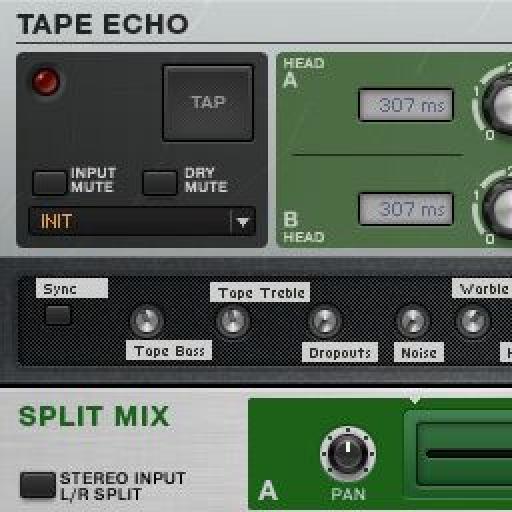The Splitter Tool in Guitar Rig is an essential rack component if you want to create any kind of dual amp setup. It can also be used for a number of other things like Stereo and multi-FX setups. Here are a couple of examples to highlight the usefulness of the Splitter Tool.
Dual Amp Setup
Guitar Rig handles dual amp setups differently from amp software like AmpliTube. Where AmpliTube has a number of predefined signal path options for single or double amp rigs, Guitar Rig lets you create your own user defined signal paths. This is achieved with the aid of the Splitter Tool.
Guitar Rig lets you create your own user defined signal paths.
The Splitter has three sections. Split A and Split B are both fed with the same input signal (this is very similar to the Splitter Utility found in Logic's Pedalboard plugin). This allows you to create two parallel signal paths that are then mixed back together by the Split Mix section.
Simply drag in a Splitter to the rack and populate Split A and Split B with two different amps. In this case I have an AC Box in A and a Citrus amp in B. I can then pan these amps left and right in the Split Mix section to get a stereo amp rig.
Populating Split A and Split B with two different amps.
We can further widen the stereo image by placing a very short delay (between 10-40ms, no feedback) before or after one of the amps. Here I've added a Psychedelay before the AC Box:
Widening the stereo image.
Each Split section can have a fully-fledged rig inside it with post and pre amp effects. You can use the balance fader (maybe connected to an expression pedal or MIDI controller) to fade between Splits (panned center), which can work well.
Stereo Effect on Single Amp
This stereo widening effect works equally well in a single amp. Place the Amp before the Splitter and leave Split A empty and then put the delay (again set between 10-40ms) into Split B and pan the splits left and right. You need to do it this way so the sound feeding the splitter is an amp tone and not a 'dry' signal. This can produce some really big sounding rhythm guitar tones.
Delaying one split.
Multi Effects Setup
The Splitter also allows you to create a custom multi effects chain and essential blend that chain of effects back in with the original sound, a bit like an Aux Send/Return scenario. Here I have an amp sound going into a Splitter. Split A is the dry signal. In Split B I have a Phaser feeding a Tape Echo set 100% wet creating some phased delay.
Creating a multi-effects chain.
Using the Split Mix fader I can blend the effected delay to taste with my dry signal.
Here is a wetter blend.
I can even pan the dry signal left and the effects right (a bit like the old Van Halen reverb trick):
Pan the dry signal to the left and wet to the right.
The Splitter can create many different signal path scenarios. Don't forget that you can put splitters inside splitters to make all kinds of blended effects and so on. The beauty is you can "MIDI Learn" the Balance faders on all of them to create some very complex animated FX.
Learn more about Guitar Rig in NI Komplete 102 and NI Komplete TNT1!










 © 2024 Ask.Audio
A NonLinear Educating Company
© 2024 Ask.Audio
A NonLinear Educating Company
Discussion
Want to join the discussion?
Create an account or login to get started!